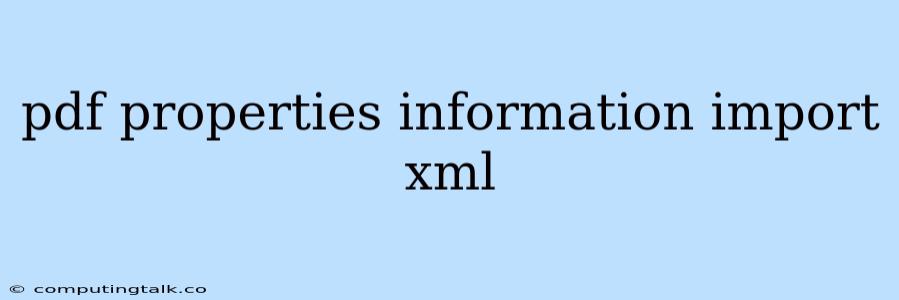Extracting information from PDF files can be a common task in many workflows. While PDFs are designed for document sharing and printing, they can also contain valuable metadata that can be used for organization, analysis, and other purposes. One method for accessing this metadata is through XML, a versatile format well-suited for structured data.
Understanding PDF Properties
PDF files, though primarily known for their visual content, store a range of properties that offer insights into the document's origin, creation, and contents. These properties, sometimes referred to as "metadata," can include information like:
- Author: The creator of the document.
- Creation Date: The date and time the PDF was created.
- Modification Date: The date and time the PDF was last modified.
- Title: A descriptive title assigned to the document.
- Subject: A brief description of the document's topic.
- Keywords: Relevant keywords associated with the document.
Importing PDF Properties into XML
Importing PDF properties into XML allows you to organize, analyze, and process this metadata effectively. This approach offers numerous advantages:
- Structured Data: XML provides a structured format for storing and representing the extracted properties.
- Machine-Readable: XML is readily understood by various applications and programming languages, facilitating automation and analysis.
- Flexibility: You can customize the XML structure to suit your specific needs and requirements.
Methods for Importing PDF Properties
There are several methods for importing PDF properties into XML, depending on your programming environment and desired level of control:
1. Python Libraries
Python offers a robust ecosystem of libraries for working with PDFs. Libraries like PyPDF2 and pdfminer.six provide functions to extract metadata from PDF files. You can then use libraries like xml.etree.ElementTree to create the XML representation of the extracted properties.
2. Java Libraries
Java also provides libraries for handling PDF files. Apache PDFBox is a popular choice that allows you to extract metadata from PDF files. You can then use Java's built-in XML handling capabilities or a library like JAXB to generate the XML output.
3. Online Tools
Several online tools offer PDF to XML conversion, often with a user-friendly interface. However, these tools typically have limitations in terms of customization and control over the output.
Example: Importing PDF Properties with Python
Let's look at an example of importing PDF properties into XML using Python:
import PyPDF2
import xml.etree.ElementTree as ET
# Load the PDF file
with open("my_pdf.pdf", "rb") as pdf_file:
pdf_reader = PyPDF2.PdfReader(pdf_file)
# Extract PDF properties
pdf_info = pdf_reader.metadata
# Create the XML root element
root = ET.Element("pdf_properties")
# Add properties as child elements
for key, value in pdf_info.items():
property_element = ET.SubElement(root, key)
property_element.text = value
# Create the XML tree
tree = ET.ElementTree(root)
# Save the XML file
tree.write("pdf_properties.xml")
This Python code imports the PDF file, extracts its properties, and creates an XML file called "pdf_properties.xml" containing the extracted metadata.
Conclusion
Importing PDF properties into XML provides a structured and efficient way to manage, analyze, and process this metadata. By utilizing libraries or online tools, you can easily extract valuable information from PDF files and leverage it for various applications. Remember to choose the appropriate approach based on your programming environment, desired level of control, and specific requirements for processing the extracted metadata.
